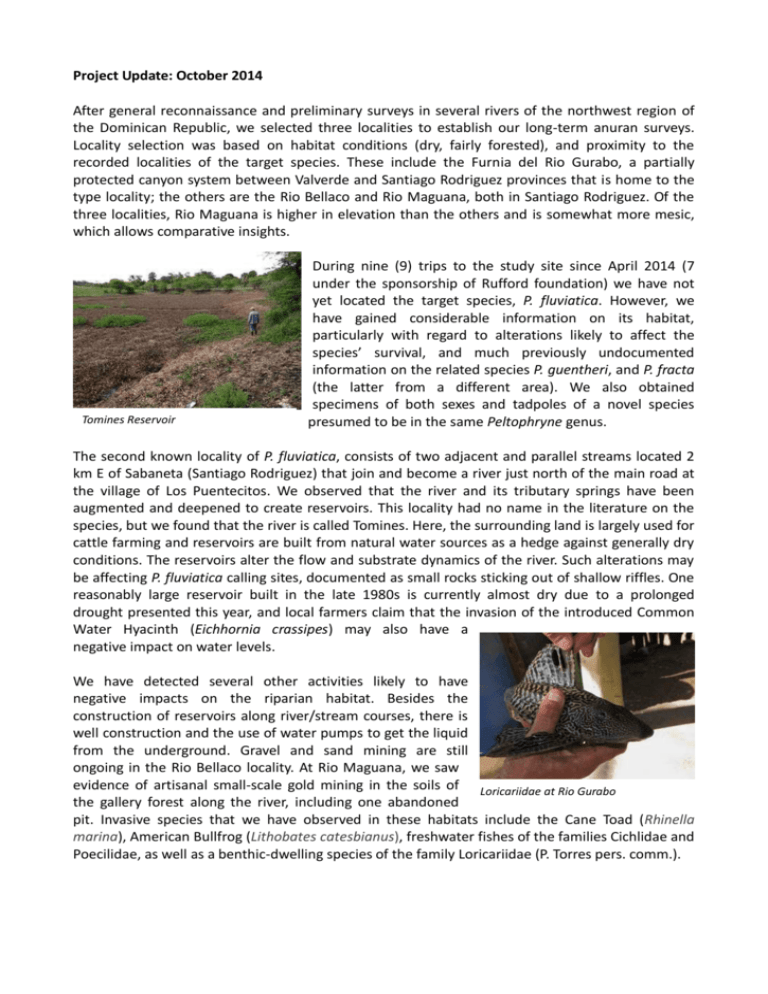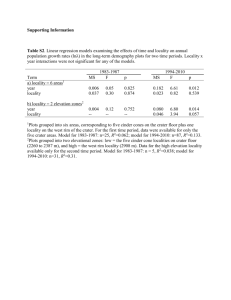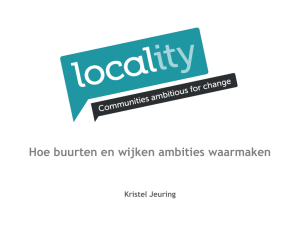September 2014 - The Rufford Foundation
advertisement

Project Update: October 2014 After general reconnaissance and preliminary surveys in several rivers of the northwest region of the Dominican Republic, we selected three localities to establish our long-term anuran surveys. Locality selection was based on habitat conditions (dry, fairly forested), and proximity to the recorded localities of the target species. These include the Furnia del Rio Gurabo, a partially protected canyon system between Valverde and Santiago Rodriguez provinces that is home to the type locality; the others are the Rio Bellaco and Rio Maguana, both in Santiago Rodriguez. Of the three localities, Rio Maguana is higher in elevation than the others and is somewhat more mesic, which allows comparative insights. Tomines Reservoir During nine (9) trips to the study site since April 2014 (7 under the sponsorship of Rufford foundation) we have not yet located the target species, P. fluviatica. However, we have gained considerable information on its habitat, particularly with regard to alterations likely to affect the species’ survival, and much previously undocumented information on the related species P. guentheri, and P. fracta (the latter from a different area). We also obtained specimens of both sexes and tadpoles of a novel species presumed to be in the same Peltophryne genus. The second known locality of P. fluviatica, consists of two adjacent and parallel streams located 2 km E of Sabaneta (Santiago Rodriguez) that join and become a river just north of the main road at the village of Los Puentecitos. We observed that the river and its tributary springs have been augmented and deepened to create reservoirs. This locality had no name in the literature on the species, but we found that the river is called Tomines. Here, the surrounding land is largely used for cattle farming and reservoirs are built from natural water sources as a hedge against generally dry conditions. The reservoirs alter the flow and substrate dynamics of the river. Such alterations may be affecting P. fluviatica calling sites, documented as small rocks sticking out of shallow riffles. One reasonably large reservoir built in the late 1980s is currently almost dry due to a prolonged drought presented this year, and local farmers claim that the invasion of the introduced Common Water Hyacinth (Eichhornia crassipes) may also have a negative impact on water levels. We have detected several other activities likely to have negative impacts on the riparian habitat. Besides the construction of reservoirs along river/stream courses, there is well construction and the use of water pumps to get the liquid from the underground. Gravel and sand mining are still ongoing in the Rio Bellaco locality. At Rio Maguana, we saw evidence of artisanal small-scale gold mining in the soils of Loricariidae at Rio Gurabo the gallery forest along the river, including one abandoned pit. Invasive species that we have observed in these habitats include the Cane Toad (Rhinella marina), American Bullfrog (Lithobates catesbianus), freshwater fishes of the families Cichlidae and Poecilidae, as well as a benthic-dwelling species of the family Loricariidae (P. Torres pers. comm.). We were able to collect a series of P. guentheri, congener and immediate neighbor of P. fluviatica, at all larval stages, including egg strings, which have never been described; also, observations on foraging juveniles, and adult and juvenile use of diurnal retreats (refugia). We are also collecting data on their thermal ecology. RT Female P guentheri Regarding the Chytridiomycosis (Bd) sampling, in spite of the relatively low amphibian activity, we have obtained more than 50 samples, which are to be sent to a US lab in the next weeks for analysis. While examining preserved specimens of P. fluviatica at two collections (Harvard Museum of Comparative Zoology and University of Kansas' Natural History Museum), I found some to have residual soil (mud/sand) on their snouts, suggesting a fossorial life-style, at least partially (refugia for aestivation) as is known in other species on the genus, and that we have also noticed in P. guentheri. The collectors that discovered P. fluviatica did not find any evidence of its diurnal retreats, even after carefully inspecting potential refugia in the proximity where the breeding choruses were active on previous nights. Landestoy and Torres collecting fish The discovery of residual soil adds to the clues that are useful and tapoles keys to our search of this elusive species. Numbers of captures at pitfall traps appear to be correlated to rainfall, which seem to trigger foraging and movement activity in some species. Besides several juvenile individuals of P. guentheri, other species that have been recorded in the traps are Giant Anoles (Anolis ricordii), the common Anolis cybotes, Hispaniolan Giant Ameiva (Ameiva chrysolaema), and Keeled Galliwasp (Celestus stenurus), along with scorpions, crickets, rats, and freshwater crabs. Data loggers are continuously recording air temperature and relative humidity (every 10 minutes) at the three sites, and we are correlating them with rainfall events. Remarkably, even 1 hour of rainfall makes a significant difference in the daily periodicity of temperature and humidity. Since our target species is suspected to be an explosive breeder likely under specific abiotic factors, we are hoping that these records may show potential patterns in which changing conditions may lead to suitability to breeding activity. Late October (1971) was the time when the species was found, and we expect a decrease on temperature and at the same time an increase in relative humidity for the Fall nights. Due to the poor amphibian activity during the months since we received the radio transmitters, no breeding activity of toads has been observed at the type locality, and there has been little activity at other localities. For this reason we have not tracked any animals other than a female P. guentheri prior to receiving the three (out of the four budgeted) BD-2 transmitters from Holohil Systems. For that only animal tracked (late May) we used a refurbished unit that had been employed previously for avian research. However, it was an interesting find recovering the female the following day of original capture using the base of a pineapple plant as a hide in an adjacent small farm from river (50 m airline). We revisited (4-5 August 2014) the vicinity of the type locality of another endemic toad, which is restricted to the eastern end of the island, P. fracta, following the passing of tropical storm Bertha expecting favorable conditions likely prone to breeding activity. Rain was probably not enough to stimulate mating, hence no choruses were detected, although we found a female foraging on a dirt road. The female was gravid but without mature oocytes at the time. Team member Robert Ortiz and I first found the species in July 2011 after 33 years unreported and we intend to publish on the rediscovery and the more recent finding in a short note. Given the often unfavorable weather conditions in the northwest, we followed better conditions as they became available in a southern locality where an undescribed toad species, presumably in the Peltophryne genus, was photographed in March 2012. We located and briefly studied this species for the first time, and successfully reared tadpoles from eggs taken from the field. We transported to our national zoo (ZOODOM) 147 tadpoles of different developmental stages in order to: 1- Start a captive breeding initiative at the ZOODOM's "amphibiary" for the family Bufonidae 2- Document ontogenetic development of all native Bufonids 3- Attempt to establish an ex-situ population The natural habitat of the new species, which is next to the Dominico-Haitian border, lies at the edge of two national parks (Jaragua and Sierra de Bahoruco), and is being rapidly destroyed by national and foreign squatters using slash-and-burn agriculture techniques. A road cutting across the (potential and so far only known locality) type locality will be paved, allowing for more access and disturbance. A nearby bauxite mine re-opened and expanded operations early this year, also causing an increase in the traffic, and roadkilled animals (iguanas, birds) have been recently reported. Returning to the northwest scenario, the administration of the protected area near the type locality of P. fluviatica, Refugio de Vida Silvestre Furnia de Gurabo, has added another ranger, and rangers will now work in teams of two, allowing them to have more presence in the river area. Prior to our field journeys none of the rangers were familiar with the target species or knew how to distinguish it from P. guentheri. The personnel are beginning to use the proper names for the species, and an introductory taxonomy and ecology workshop to the species that can be found in the area is scheduled for our next visit (late September to early October). This workshop will allow the personnel and other interested villagers to recognize the species in the field with accuracy. We will use photographs, illustrations and sound recording of anuran vocalizations, as well as display and distribute the updated species list for the area. The principal team members of the project, M.A. Landestoy and R. Ortiz, recently conducted a talk (on Friday September 26) about valuation of natural resources, which also included the current project, at Centro Cultural Perelló in the town of Baní, Peravia. A talk exclusively about this project is also planned for October at the community neighboring the type locality, Los Quemados in Valverde province.









